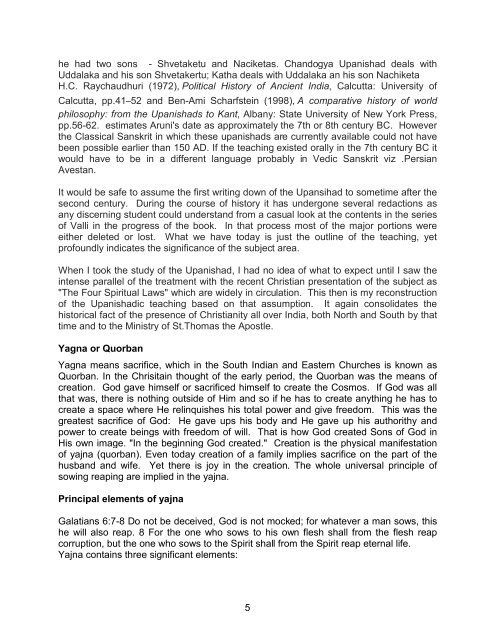KathaUpanishad
You also want an ePaper? Increase the reach of your titles
YUMPU automatically turns print PDFs into web optimized ePapers that Google loves.
he had two sons - Shvetaketu and Naciketas. Chandogya Upanishad deals with<br />
Uddalaka and his son Shvetakertu; Katha deals with Uddalaka an his son Nachiketa<br />
H.C. Raychaudhuri (1972), Political History of Ancient India, Calcutta: University of<br />
Calcutta, pp.41–52 and Ben-Ami Scharfstein (1998), A comparative history of world<br />
philosophy: from the Upanishads to Kant, Albany: State University of New York Press,<br />
pp.56-62. estimates Aruni's date as approximately the 7th or 8th century BC. However<br />
the Classical Sanskrit in which these upanishads are currently available could not have<br />
been possible earlier than 150 AD. If the teaching existed orally in the 7th century BC it<br />
would have to be in a different language probably in Vedic Sanskrit viz .Persian<br />
Avestan.<br />
It would be safe to assume the first writing down of the Upansihad to sometime after the<br />
second century. During the course of history it has undergone several redactions as<br />
any discerning student could understand from a casual look at the contents in the series<br />
of Valli in the progress of the book. In that process most of the major portions were<br />
either deleted or lost. What we have today is just the outline of the teaching, yet<br />
profoundly indicates the significance of the subject area.<br />
When I took the study of the Upanishad, I had no idea of what to expect until I saw the<br />
intense parallel of the treatment with the recent Christian presentation of the subject as<br />
"The Four Spiritual Laws" which are widely in circulation. This then is my reconstruction<br />
of the Upanishadic teaching based on that assumption. It again consolidates the<br />
historical fact of the presence of Christianity all over India, both North and South by that<br />
time and to the Ministry of St.Thomas the Apostle.<br />
Yagna or Quorban<br />
Yagna means sacrifice, which in the South Indian and Eastern Churches is known as<br />
Quorban. In the Chrisitain thought of the early period, the Quorban was the means of<br />
creation. God gave himself or sacrificed himself to create the Cosmos. If God was all<br />
that was, there is nothing outside of Him and so if he has to create anything he has to<br />
create a space where He relinquishes his total power and give freedom. This was the<br />
greatest sacrifice of God: He gave ups his body and He gave up his authorithy and<br />
power to create beings with freedom of will. That is how God created Sons of God in<br />
His own image. "In the beginning God created." Creation is the physical manifestation<br />
of yajna (quorban). Even today creation of a family implies sacrifice on the part of the<br />
husband and wife. Yet there is joy in the creation. The whole universal principle of<br />
sowing reaping are implied in the yajna.<br />
Principal elements of yajna<br />
Galatians 6:7-8 Do not be deceived, God is not mocked; for whatever a man sows, this<br />
he will also reap. 8 For the one who sows to his own flesh shall from the flesh reap<br />
corruption, but the one who sows to the Spirit shall from the Spirit reap eternal life.<br />
Yajna contains three significant elements:<br />
5


















